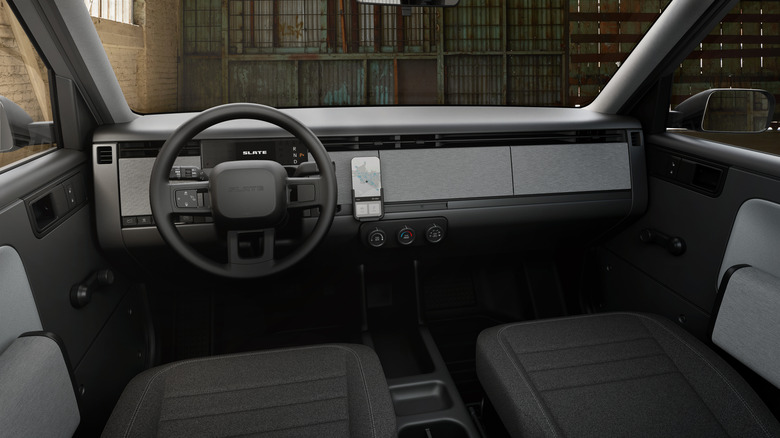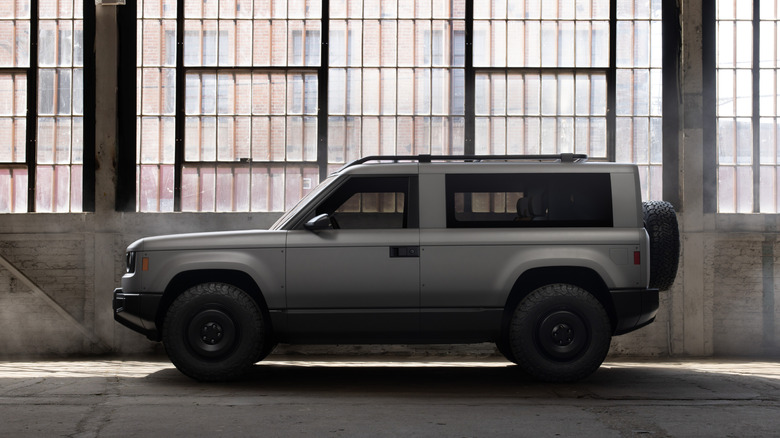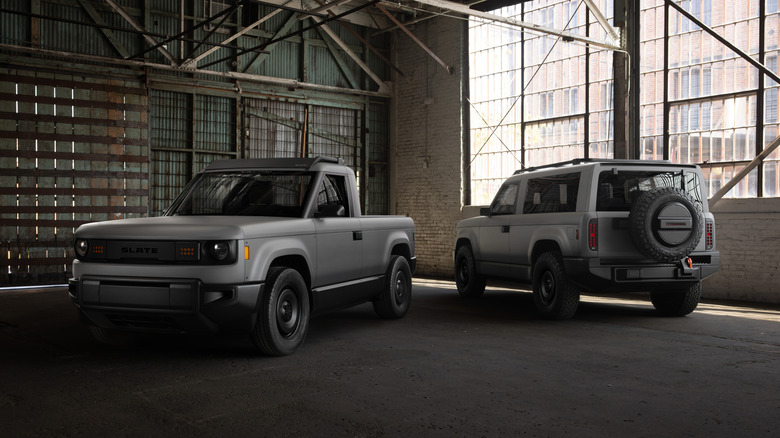Slate's EV Mini Truck Is Cool, But There's A Good Reason Nobody Has Tried It Before
Slate Auto, an electric vehicle startup, has just announced its first vehicle, the Slate Truck, set to be delivered next year. On paper at least, the Slate is downright cool. It's a two-door electric pickup with a short bed and apparently hundreds of different ways to customize it. According to Slate, it can be outfitted to fill whatever role you want it to and can even be converted into a tiny SUV via an optional kit.
The interior is bare bones, with old school crank windows, and it doesn't even come with an infotainment screen. The idea is that you use your phone for music or navigation, or purchase a kit from Slate. It's basically a mini truck from the 1980s or a kei truck from Japan, only with a decidedly modern power train.
The Slate's electric power train isn't exactly Hummer EV levels of powerful or capable, but it's plenty for the most part. It has a single 201 horsepower motor, allowing for only rear wheel drive. The battery has a capacity of 52.7 kilowatt hours, and the optional larger battery bumps that up to 84.3 kilowatt hours. That allows for 150 miles and 240 miles of range respectively. Here's the real draw of the Slate. It's slated to start at around $27,500, making it one of the least expensive EVs on the market. Taking into account federal tax credits – that not everyone qualifies for, and which are politically precarious – the price could be closer to $20,000.
A funky little truck
The Slate has a maximum payload of 1,433 pounds, putting it right within the capabilities of the Ford Maverick (which has a maximum capacity of 1,500 pounds). Towing is rated at 1,000 pounds, which is frankly pretty mediocre for a truck, considering a base model Maverick can tow 2,000 pounds and it can be upgraded to 4,000 pounds.
On the surface, the Slate is certainly eye catching. It looks like something straight out of CyberPunk 2077 and the idea of mini truck with an efficient electric drivetrain is certainly appealing. Provided it launches on time, and everything goes to plan for Slate (there's always a big "if" when it comes to EV startups), the Slate could probably find a healthy home in a small delivery fleet, or be used as a parts runner car or even a funky little food truck. However, there's a huge reason why no one has really tried to make the Slate before: it's too specialized, perhaps too bare bones, and it's probably not a fit for the mass market.
It's wacky, but that's not enough
Enterprising gearheads and Lego enthusiasts (I am one of them) will love the Build-Your-Own-Truck idea that Slate is running with. It's certainly a fresh take on customization that will attract the DIYers among the car buying public. To your average commuter however, a Hyundai Ioniq5 is more expensive, but you get an actual fully-functioned car that doesn't have crank windows. The Hyundai also has onboard navigation, roughly twice the range, and you don't have to build the ability to fit more than two people.
As a truck, something like the aforementioned Ford Maverick is probably still a better fit for a lot of people. The hybrid drivetrain is significantly more convenient for people who value time like tradesman and contractors, and the significantly beefier specs make it more attractive all around for hauling or as a light towing rig. The Ford also costs a little less than the Slate at a starting price of $23,920 and it's available in all-wheel drive. The Slate is cool and capable, it just isn't enough.
Your average driver likes the idea of limitless customization, but the actual practice of having to essentially build your own car might not move that many units. Pair that aspect with frankly mediocre specifications, and the Slate has a very limited audience. That said, no one is rooting for the Slate's demise. The EV world could use a little more non-Elon Musk related wackiness.
It's not the normal approach
When other high profile EVs like the Hummer EV, Ford F-150 Lighting, or the Rivians came out, the first available models were the decked-out versions with every single bell and whistle. To the customer, that approach showed the extent of what each vehicle was capable of when it came to range and features: it certainly doesn't hurt to be able to boast of supercar-beating 0-60 mph times, or vast amounts of electric range.
At the same time, it gave each automaker the much needed cash to ramp up production, building (and hopefully subsequently selling) more cars. Only after that cash and customer base was established would the automaker cut down the price, removing features to widen the appeal (not to mention also be able to meet that increased demand, once the early and inevitable production glitches had shaken out).
Slate isn't doing that, and is instead to a large extent appealing to people who are shopping for price. That approach makes headlines, certainly, but can be a dangerous double-edged sword, since people who shop for price expect value and features for their hard-earned money. The Slate doesn't offer that, if you aren't willing to DIY it into something more capable yourself. For someone who just wants cheap transportation, something like a Nissan Sentra offers objectively more features, while an EV like the Hyundai Ioniq5 or Nissan Leaf give you better value. Final, detailed pricing — and investors like Amazon's Jeff Bezos being willing to foot the bill to ramp things up — may make all the difference for whether Slate sinks or succeeds.



